Here’s a quick-start guide to help you avoid frustration and set you up for success. While there isn’t one single “magic” tenkara level line length, there are easy guidelines that will help you get the right rig for you and the fishing you’re doing.
The basic guideline to get you started would be to set the length of your tenkara line to the same length as your rod – plus or minus about 12″.
The reasons for – and benefits of – going outside this range are discussed in the rest of this article.
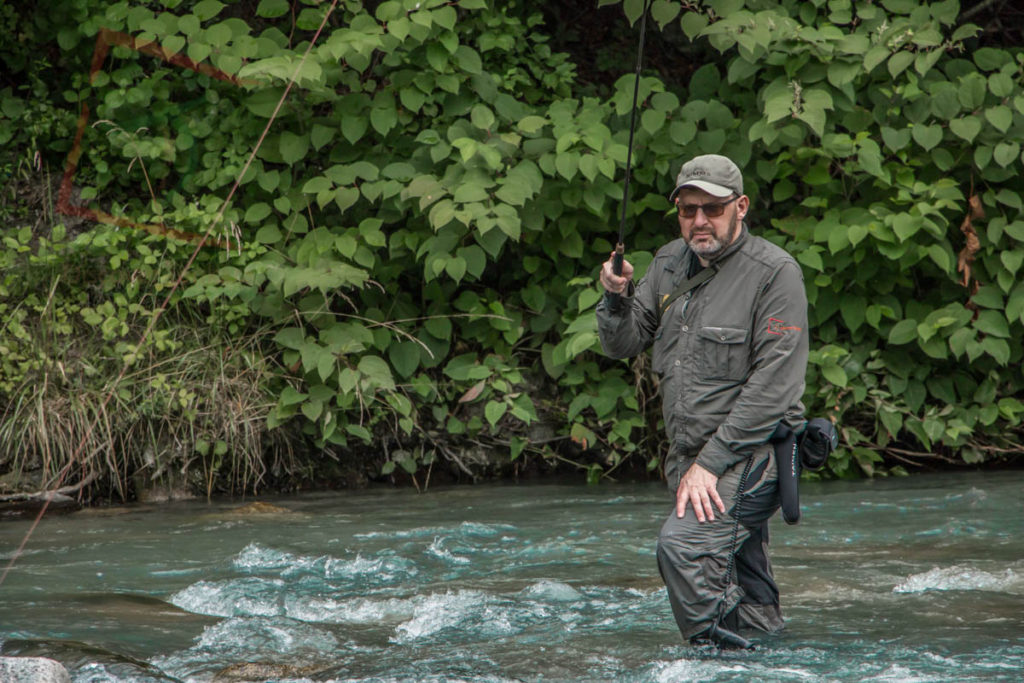
Having said there’s no single magic length in feet and inches (which is true) – there IS a nearly Universal level line length formula for you to start practicing your casting with. The trick is to set that against the length of your rod as your measure (not the measuring tape). The great thing about this is it is quite a loose definition and so is fairly forgiving and allows quite a lot of “give and take”.
The other nice thing about that ideal practice length is that, in the ideal surroundings where you can reach the fish and you don’t struggle with raising the rod vertical due to tree canopy, it is also a pretty ideal fishing length too.
Let’s have a look at that “go to” basic level line length now…
Tenkara Level Line Length: The Preferred Universal Option
OK are you ready? The best level line rig to learn casting with – AND to fish with – is:
“About the length of your full tenkara rod PLUS or MINUS the length of the handle”
So, measuring from the tip of your rod (when it is straight!) down to the butt-cap at the end of the handle is the full rod-length.
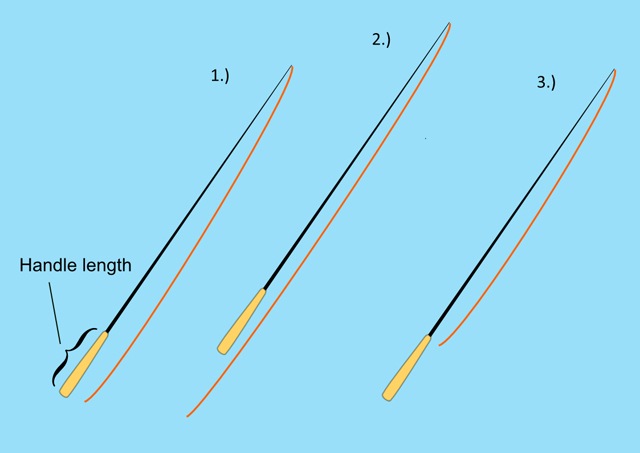
For the most accuracy and the greatest ability to hold all the casting line (and most/all of the tippet) off the water – make the tip of your casting line (where it joins onto your tippet) line up with the front edge of the handle (Option 3 in the diagram above).
For a bit more reach and separation from the fish, make that casting line/tippet joint project about a handle’s length beyond the butt (Option 2 in the diagram above).
Tenkara Level Line Length for ZOOM (multi-length) rods
A great formula for zoom rods is to set the length of the casting line so that the tippet/casting line joint reaches about half way down the handle when the rod is fully extended.
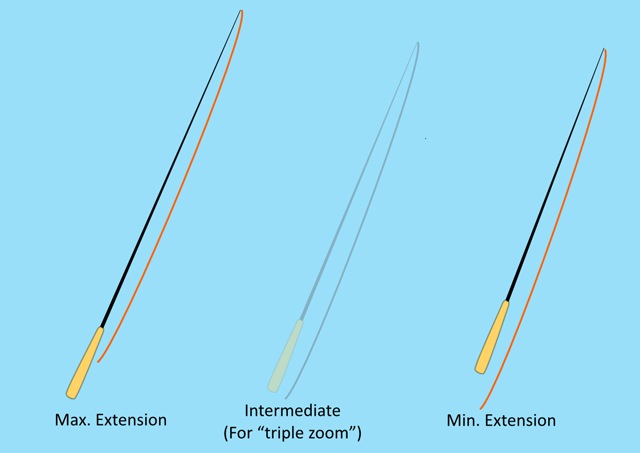
That way, at its shortest length, you’ll be laying a manageable length of line on the water with longer casts; whereas at longer lengths you’ll have greater accuracy and ability to hold the line off (without struggling to bring fish to hand because your line is too short). BTW – if you’re interested in understanding more about modern and traditional tenkara rods, here’s a handy detailed guide to tenkara rods
Special level line lengths for different tactics/conditions
Because you encounter different types of streams and different conditions – and you’ll also fish a range of different tactics – it’s important to be able to adapt your line to make your life as easy as possible.
“Honryu” Tenkara Level Line Length
Honryu (big, powerful main-river) fishing venues are often tackled by keen tenkara anglers in Japan. Their greater size, power and depth often limits how close you can stand to the target area that you want to fish. This means that it is often an advantage to modify your tackle and rigs in order to still catch fish. Obviously we should mention our Karasu-400 rods in relation to these types of venues!
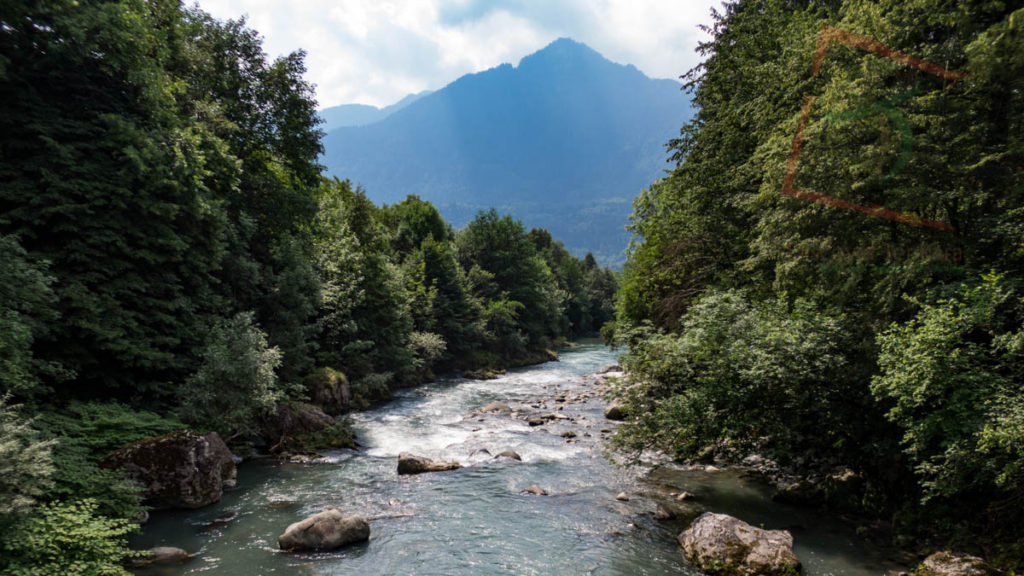
First of all, choosing a longer rod is a huge advantage – since it allows you to hold more line off the water over the fast currents and white water between your stance and the spot you want your fly to swim.
Secondly, it CAN be an advantage to use a much longer line than usual – but don’t rush to that do that. Always remember that the best tenkara level line length is as short as possible – but no shorter.
Short means accurate. Short means control. Don’t give those advantages up too cheaply.
Those casting lines that hover around the length of the rod will always give a nice balance of “short but not too short”. Lines that are a good deal shorter than the rod will need a tippet that is long enough to allow you to land fish (the subject of another article!) and are not designed for providing casting performance (they are more likely to be used to fish European nymphing tactics on a tenkara rod – rather than to fish tenkara techniques).
Longer Tenkara Level Lines 1: Light/Surface fishing
Whether it is an ultralight level line (#3 nylon on the Japanese diameter scale) for zero wind or a relatively light fluorocarbon line (#2.5) for “sailing” on the wind – a soft-action 4 to 4.5m tenkara rod can be used to fish long-line tactics. Those lines are typically be anywhere between 5m and 8m in length. Please check out Manipulations Vol. 1 for “line-sailing” demonstration in full.
The way to judge is that they need to be long enough to reach the features you want to fish (or separate you sufficiently from really spooky fish in flat water) – but not any longer than necessary. The most common and preferred lengths of light level tenkara line tend to be in the 5.5 to 6-m range.
Of course there are always exceptions, but it is an effective tactic to pair those longer, light lines with unweighted wet flies fished at the surface. These are typically in smaller sizes and sporting a stiff hackle that can slow the sink-rate of the fly and/or help it fish close to the surface.
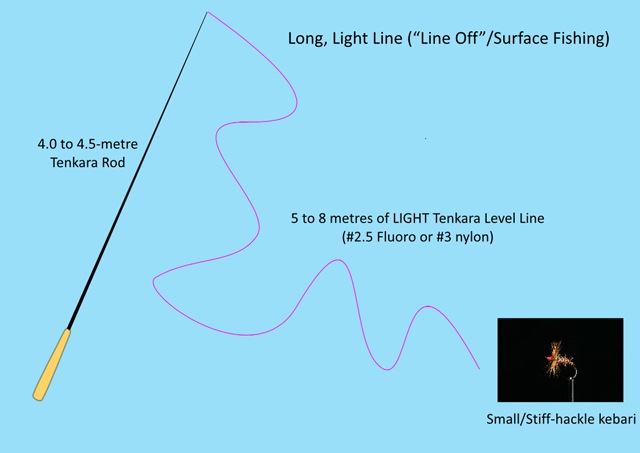
Great exponents of this approach include Kazuo Kurahashi (and of course many others, but Kura-san is really the one who pushed forward with refining the #3 nylon tactics). Also, to avoid the many common myths about the flies used in tenkara (kebari) – particularly the idea that the stiff hackled wet flies are “tenkara dry flies” and that reverse-hackled flies are the most commonly-used tenkara patterns; you can get some good pointers from our guide to tenkara flies article.
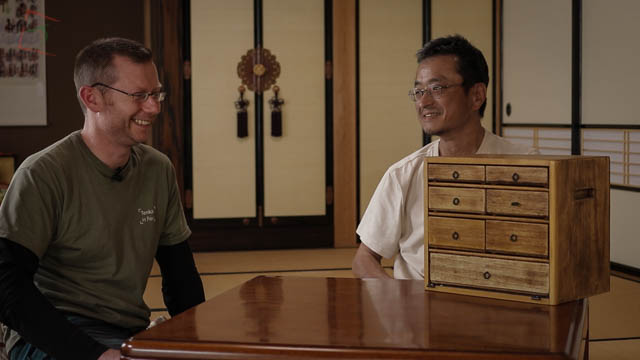
Longer Tenkara Level Lines 2: Masami’s BIG fly disruption tactics
Masami Sakakibara (AKA Tenkara-no-Oni or “Tenkara Ogre/Demon”) is an exceptional caster and also famous for sometimes using really big, soft-hackle kebari (flies). He favours using a 4m “Oni Type II” 5:5-actioned rod to cast a #4 or #4.5 level fluorocarbon line of between 7 to 10 metres on powerful sections of the Toyama river. In extreme cases, he may use a 12-m casting line, plus a relatively long tippet.
As well as a longer tippet, Masami likes coupling that long-line setup with his giant sakasa kebari (reverse hen-pheasant hackle, black dubbed body on a size 6, 4 or 2 long-shank hook).
He then smoothly powers that long rig out over the top of brutal flows of deep water into huge, circulating back-eddies and boulder-current-features. The long tenkara rod allows him to hold the main belly of the casting line above the nagging currents – so that only line and tippet that lays in the softer flows he wants to fish.
The whole purpose is to allow him to enticingly pulsate that huge hackle just below (or even on) the surface of the glassy water to draw fish up from the depths to strike at the large mouthful of “prey”.
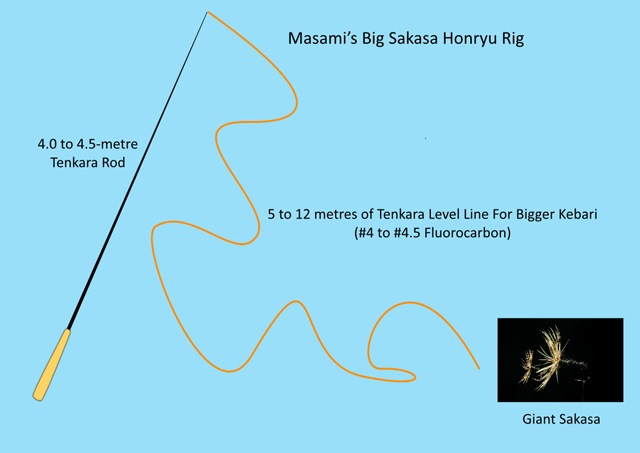
When there is less wind, Masami might use long, tapered nylon “Fujino” lines to present flies on the surface (since these are less dense and can also be coated with floatant).
He may also use the denser fluorocarbon rig to fish the unweighted flies that he prefers to use at a greater depth. If you are interested in Oni Type II rods, at the time of writing they are supplied in the USA by Team Oni USA.
Note: We do not receive any payments or have any business relationship with any “Oni” rods suppliers, so the links above are supplied purely as relevant resources to the tactics outlined in this section.
Longer Tenkara Level Lines 3: Kazumi Saigo & Dr Ishigaki Bead-head Honryu Tactics
Generally based on fluorocarbon tenkara level lines of between #3 and #4, it was (surprisingly) Dr. Ishigaki who first showed us these specialised bead-head “Honryu” tactics that he had been encouraged to explore by “Ajari” (Kazumi Saigo) – one of the most prolific and successful modern Japanese tenkara anglers.
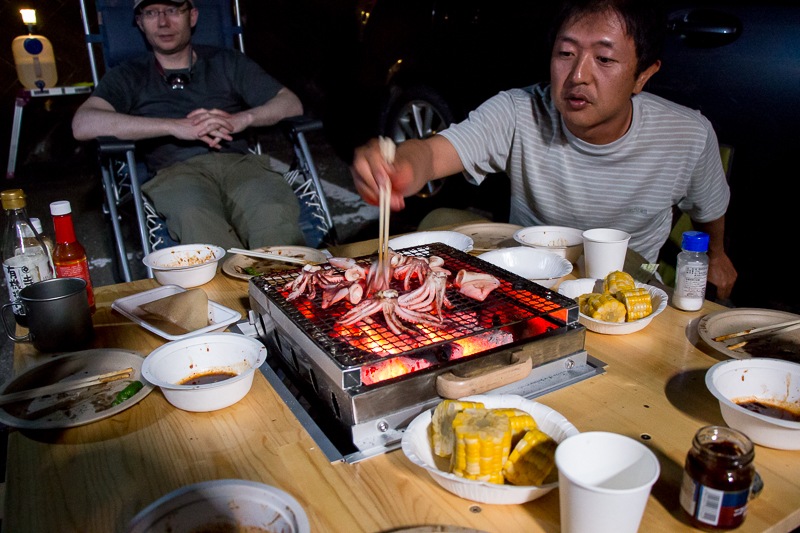
Ajari is the guy who everyone calls when they need to catch fish for a magazine photo-shoot!
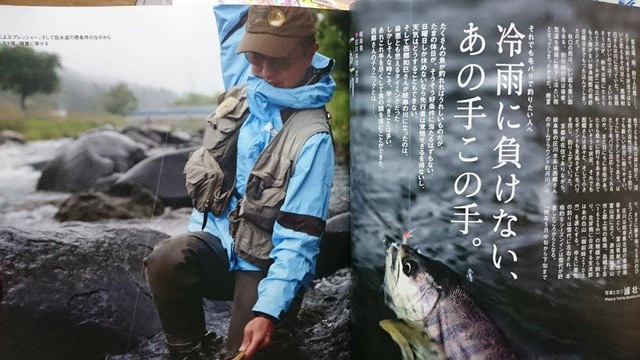
It is REALLY important to distinguish this presentation style from the (also highly refined) European Competition nymphing tactics using tungsten bead-head flies. Both the rig AND the effect you are looking to create are very different from western competition styles.
The basic rig is 6 to 8 metres of fluorocarbon tenkara level line, plus up to 2 metres of tippet. There is only one fly attached to the tippet and this carries a tungsten bead-head of anywhere between 3mm and 4mm diameter, depending on the power and depth of the water.
Unlike European competition nymphing approaches (in fact more similar to streamer-fishing presentations), the aim is usually to fish the mid-water column. BUT, the key detail is that you are manipulating the fly quite deliberately and aiming for a relatively “flat” trajectory of the fly.
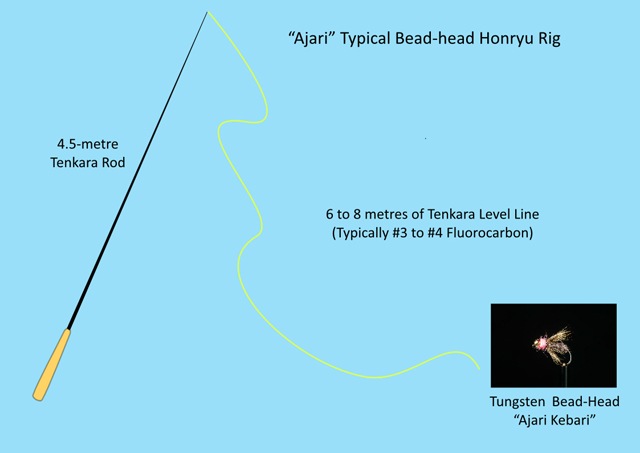
This approach targets the predatory instincts of iwana, amago and yamame (especially the larger specimens) in these cobalt-blue, intimidatingly deep and powerful Japanese Honryu rivers.
The rod will also typically be a 4.5-m long model – as this allows the maximum reach and control of the level line over the currents. It also allows the angler a great degree of control of the pulsations of the line and the fly.
I can see many applications for this technique on many rivers around the world where predatory trout swim…
Tenkara Level Line Length: Round-up
If nothing else, the major point to take away from this article is that:
- The casting line should always be as short as it is possible – even when you are deliberately extending that reach on larger rivers.
- Particularly during the stages of really nailing down your level line tenkara casting, you should use a casting line that is approximately the full length of the rod
- Tweaking that within the bounds of the length of the handle on your rod is the ideal first step to modifying that line length to adapt more precisely to specific tactics
Going to for much larger rivers and longer casting-ranges benefits from matching the material, diameter and length of the level line to cope with wind, depth and the ability to hold more/less line off the surface with varying degrees of “Drape Otsuri”.
To complete your understanding of tenkara level line length and rig-setup; please check out my article on tenkara tippet length.
Finally, if you want to get the best results out of the patterns that you tie, make sure to go through our Western Fly Fishing and Tenkara Tutorial Series of FREE email Tuition:
Click to Get Free Access to Over A Year of Tuition
PaulPS – Don’t forget to “share”, with our thanks, if you found this useful.

Killer article, Paul. I didn’t realize that the beadhead kebari technique was very much different than the Euro Competition techniques. That’s good to know! I’ll have to look into it further for some of the bigger rivers around here.
Thanks Daniel Please feel free to update me (with or without photos) on any interesting results on bigger venues 🙂
Paul
After doing my first Tenkara steps by using a “Standard Rig” 12 feet of rod and line in combination of 1m of tippet, I did try a longer line and tippet. Although I have trained a lot my accuracy has been less good. It has took a longer time to see what I’m doing wrong. I had to reduce the length of my rig. Now I’m happy to work fine on the water. Thanks for this nice post.
Lovely stuff Eberhard and thank you for your kind feedback.
Paul